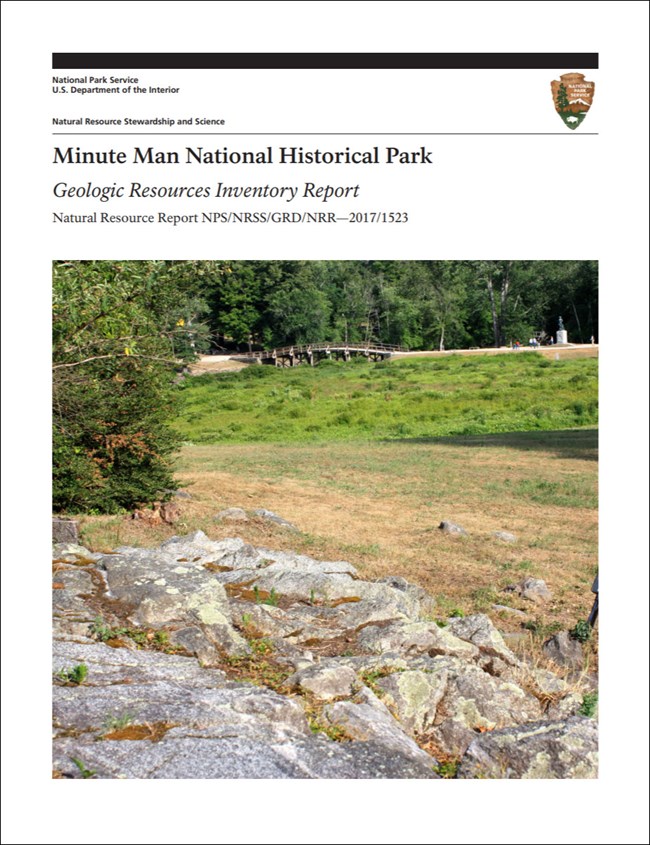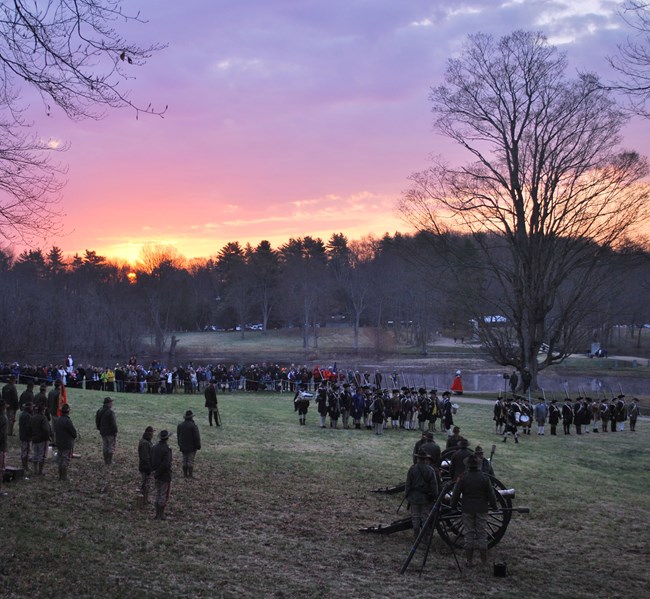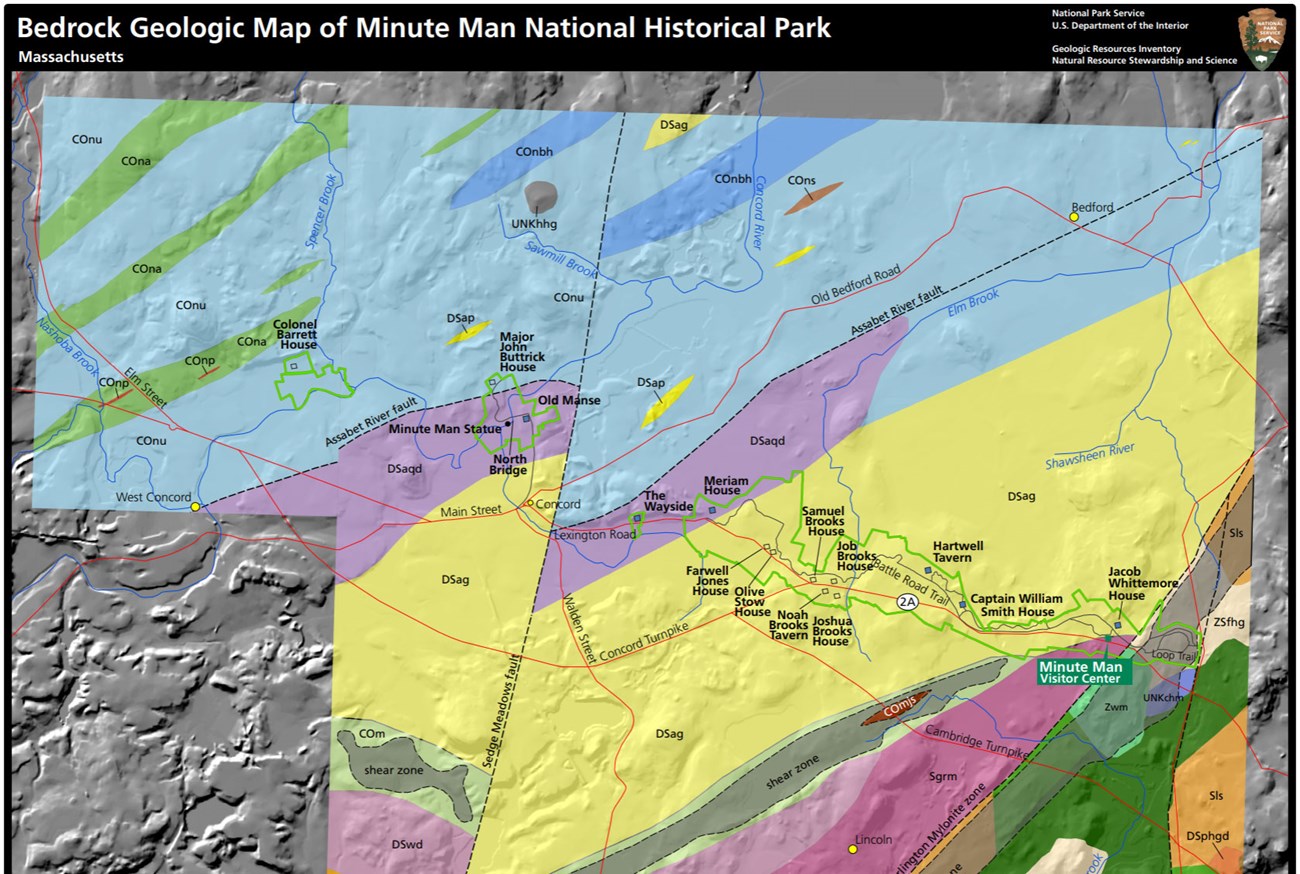Last updated: July 10, 2024
Article
NPS Geodiversity Atlas—Minute Man National Historical Park, Massachusetts
Geodiversity refers to the full variety of natural geologic (rocks, minerals, sediments, fossils, landforms, and physical processes) and soil resources and processes that occur in the park. A product of the Geologic Resources Inventory, the NPS Geodiversity Atlas delivers information in support of education, Geoconservation, and integrated management of living (biotic) and non-living (abiotic) components of the ecosystem.

Introduction
Minute Man National Historical Park (MIMA) is comprised of four park units in the cities of Concord, Lexington, and Lincoln in Middlesex County, Massachusetts. Established on September 21, 1959, MIMA contains about 415 hectares (1,027 acres) and protects the significant historic structures and landscapes associated with the opening of the American Revolution. Another major purpose of MIMA is to preserve resources related to America’s literary tradition, including the Wayside—home to acclaimed authors Louisa May Alcott, Nathaniel Hawthorne, and Margaret Sidney (National Park Service 2015a). The historical park is named in honor of the “minute men”, the volunteer militia forces of Massachusetts that were trained to march against the British at a minute’s notice. MIMA commemorates the “shot heard ‘round the world”, the first armed conflict of the American Revolution between British soldiers and colonists that took place on April 19, 1775. When British troops marched west from Boston to confiscate and destroy munitions cached by the colonists at Concord, an initial deadly skirmish left eight colonists dead and inspired local militias and minute companies to attack the British. The historical park consists of four park units (Battle Road Unit, North Bridge Unit, Wayside Unit, Bartlett’s Farm Unit) that feature restored sections of Battle Road between Lexington and Concord, a route along which colonists battled British forces; the North Bridge that crosses the Concord River; the Minute Man Statue; historic monuments and structures; and the Wayside (Thornberry-Ehrlich 2017b).
Geologic Setting
The geology of Minute Man National Historical Park represents part of the Avalon and Nashoba terranes, two foreign landmasses that collided with the eastern margin of ancestral North America (Laurentia) around 425 Ma (Robinson and Kapo 2003). The historical park straddles the fault boundary between these two terranes, which is defined by the Burlington Mylonite Zone-Bloody Bluff Fault. The bedrock of MIMA consists of metamorphic and igneous rocks spanning from the Cambrian through the Devonian that have been offset along the Sedge Meadows Fault or juxtaposed against rocks of different age and lithology across the Burlington Mylonite Zone-Bloody Bluff Fault (Thornberry-Ehrlich 2017b). The oldest rocks in the park are mapped in the Battle Road Unit on the eastern side of the Burlington Mylonite Zone-Bloody Bluff Fault and consist of the Neoproterozoic– Silurian Fiske Hill Granite. Metamorphic strata of the Cambrian–Ordovician Nashoba Formation underlie the Bartletts Farm Unit and a portion of the Wayside Unit. Rocks of similar age of the Marlboro Formation occur in a small area of the Battle Road Unit just south of the Paul Revere Capture Site. The predominant bedrock of MIMA is comprised of Silurian and Devonian-age granitic rocks associated with the Andover Granite, Assabet Quartz Diorite, and Sudbury Granite that form the foundation of the Battle Road, North Bridge, and Wayside units. Overlying the ancient bedrock of MIMA are unconsolidated, Quaternary-age surficial deposits that include glacial till, stratified glacial deposits, post-glacial swamp deposits, and floodplain alluvium (Thornberry-Ehrlich 2017b).
Regional Geology
Minute Man National Historical Park is a part of the New England Physiographic Province and shares its geologic history and some characteristic geologic formations with a region that extends well beyond park boundaries.
- Scoping summaries are records of scoping meetings where NPS staff and local geologists determined the park’s geologic mapping plan and what content should be included in the report.
- Digital geologic maps include files for viewing in GIS software, a guide to using the data, and a document with ancillary map information. Newer products also include data viewable in Google Earth and online map services.
- Reports use the maps to discuss the park’s setting and significance, notable geologic features and processes, geologic resource management issues, and geologic history.
- Posters are a static view of the GIS data in PDF format. Newer posters include aerial imagery or shaded relief and other park information. They are also included with the reports.
- Projects list basic information about the program and all products available for a park.
Source: NPS DataStore Saved Search 3014. To search for additional information, visit the NPS DataStore.
A NPS Soil Resources Inventory project has been completed for Minute Man National Historical Park and can be found on the NPS Data Store.
Source: NPS DataStore Saved Search 3061. To search for additional information, visit the NPS DataStore.
GRI Geology Image Gallery

Related Links
Related Articles
Minute Man National Historical Park
National Park Service Geodiversity Atlas
The servicewide Geodiversity Atlas provides information on geoheritage and geodiversity resources and values within the National Park System. This information supports science-based geoconservation and interpretation in the NPS, as well as STEM education in schools, museums, and field camps. The NPS Geologic Resources Division and many parks work with National and International geoconservation communities to ensure that NPS abiotic resources are managed using the highest standards and best practices available.

